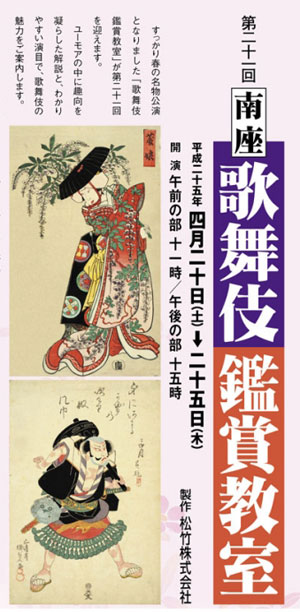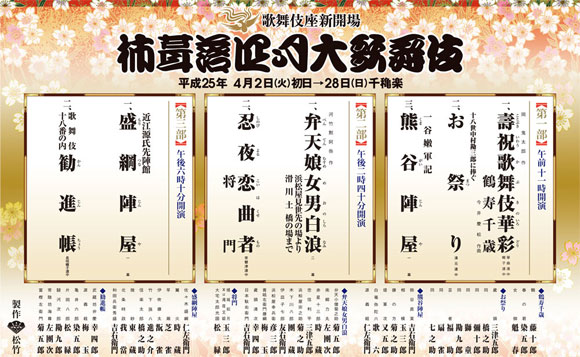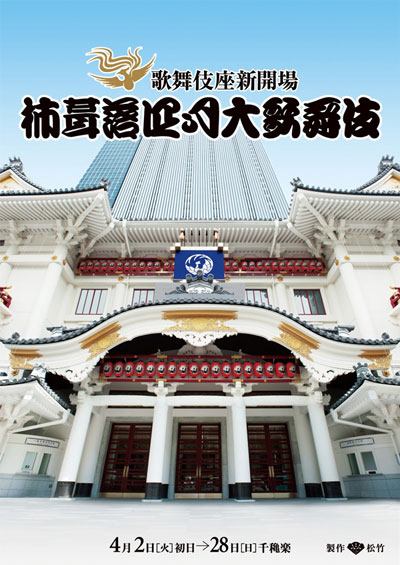| Dates |
2 ~ 28 April 2013 (Kokera Otoshi Shigatsu ďkabuki)
Opening Ceremony April Grand Kabuki |
| MatinÚe |
Kotobuki Iwau Kabuki no Irodori (Kakuju Senzai)
Omatsuri
Ichi-no-Tani Futaba Gunki (Kumagai Jin'ya)
|
| Afternoon |
Benten Musume Meo no Shiranami
Hamamatsuya
Kuramae
Inasegawa Seizoroi
Gokurakuji Yane Rippuku
Sanmon
Namerigawa Dobashi
Shinobi Yoru Koi no Kusemono (Masakado)
|
| Evening |
ďmi Genji Senjin Yakata
(Moritsuna Jin'ya)
Kanjinch˘
|
| Casting |
Kataoka Nizaemon, Band˘ Tamasabur˘, Onoe Kikugor˘, Sakata T˘jűr˘, Nakamura Kichiemon, Matsumoto K˘shir˘, Band˘ Mitsugor˘, Nakamura Hashinosuke, Nakamura Kanjaku, Nakamura Shibajaku, Nakamura Tokiz˘, Onoe Kikunosuke, Nakamura Baigyoku, Nakamura Kaishun, Nakamura Fukusuke, Nakamura Senjaku, Kataoka Gat˘, Ichikawa Sadanji, Ichikawa Danz˘,
Band˘ Hikosabur˘, ďtani Tomoemon, Nakamura T˘z˘, Nakamura Matagor˘, Nakamura Kankur˘, Nakamura Shichinosuke, Onoe Sh˘roku, Band˘ Yajűr˘, Nakamura Karoku, Nakamura Shid˘, Ichikawa Somegor˘, Kataoka Shinnosuke,
Kataoka Ichiz˘, Nakamura Kinnosuke, Kataoka Kamez˘, Nakamura Kikaku, Kawarasaki Gonjűr˘, Ichikawa Omez˘, Ichikawa Komaz˘, Matsumoto Kingo, Sawamura Yoshijir˘, Nakamura Kash˘, ďtani Keiz˘, Band˘ Kamesabur˘, Band˘ Kametoshi, Sawamura S˘nosuke, Nakamura Matsue, Onoe Matsuya, Onoe Ukon, Nakamura Baishi, Nakamura Mantar˘, Nakamura Kazutar˘, ďtani Hirotar˘, ďtani Hiromatsu, Band˘ Shingo, Nakamura Kotar˘, Nakamura Yonekichi, Nakamura Tanenosuke, Matsumoto Kintar˘,
Nakamura Tamatar˘, Nakamura Muneo, Nakamura Kunio, Nakamura Yoshio, Nakamura Toranosuke, Fujima Taiga
|
| Comments |
Opening of the new Kabukiza and the beginning of a 1-year long cycle of kokera otoshi programs!
Kakuju Senzai: an elegant dance of the crane to celebrate the Grand Opening of the new Kabukiza Theatre.
In Japanese tradition the crane is thought to be an auspicious creature and live for a thousand year. Featuring Living National Treasure Sakata T˘jűr˘, Nakamura Kaishun and Ichikawa Somegor˘.
Omatsuri: the gallant commoners of an Edo neighborhood loved nothing better than a festival (matsuri).
This short dance shows a gallant fireman, the hero of the commoners and then shows the festival shishi lion
spirit running wild in a dance-like fight with the energetic young men of the festival. Staged in memory of late Nakamura Kanzabur˘ XVIII.
Featuring Band˘ Mitsugor˘, Nakamura Hashinosuke, Band˘ Yajűr˘, Nakamura Shid˘, Nakamura Kankur˘, Nakamura Fukusuke, Nakamura Senjaku and Nakamura Shichinosuke.
Kumagai Jin'ya: this play is a dramatization of the clash between the Genji general Kumagai Jir˘ Naozane
and the Heike warrior Taira no Atsumori at the battle of Ichi-no-Tani, one of the most famous passages of the epic
"Tales of the Heike". In the Kabuki version, on the cryptic orders of the Genji leader Yoshitsune,
Kumagai hides the enemy warrior Atsumori and has his own son take the warrior's place.
On the battlefield, Kumagai has to kill his own son in Atsumori's place.
Things become worse when his wife Sagami and Atsumori's mother Fuji-no-Kata arrive at his camp.
In the highlight of the play, he tells them the story of his mortal battle with Atsumori, keeping Atsumori's well-being and his own sacrifice a secret.
He then shows the head of Atsumori for inspection by his leader to see if he has interpreted his orders correctly.
This performance stars Nakamura Kichiemon as Kumagai,
with Band˘ Tamasabur˘ as Kumagai's wife Sagami,
Onoe Kikunosuke as Fuji-no-Kata,
Kataoka Nizaemon as Yoshitsune and
Nakamura Karoku as Midaroku.
Benten Musume: written by Kawatake Mokuami in 1862, this play was
inspired by a woodblock print of a sexy young man with tattoos covering his body with a woman's hairstyle and
kimono. A beautiful young woman comes to a clothing store with her servant, but is discovered shoplifting
and beaten. When she proves that she was not stealing, her servant demands compensation. However, a
samurai who happens to be in the store reveals that the young woman is actually a man, and he proudly announces
his name as Benten Koz˘ (Onoe Kikugor˘), the thief. The servant is his fellow gang member Nang˘ Rikimaru (Ichikawa Sadanji) and the samurai
is actually the head of the gang Nippon Daemon (Nakamura Kichiemon). The scene showing the five members of the gang in their finest
kimonos under the cherry blossoms in full bloom is a kind of spectacle.
In elaborate speeches, they each announce their name in the poetic diction for which the playwright Mokuami
is famous. Benten, the thief drops the precious gold-lacquered incense container with plovers drawn on it into
the Namerigawa River as he is surrounded by police officers betrayed by one of his fellows.
He then commits suicide by stabbing himself with his sword in the stomach. Nippon Daemon is pursued by other
police officers. The magistrate Aoto Saemon Fujitsuna (Nakamura Baigyoku) picks up the precious incense container from the
Namerigawa River and parts with Nippon Daemon in the hope of meeting again in some day.
Featuring also Band˘ Mitsugor˘ as Tadanobu Rihei and Nakamura Tokiz˘ as Akaboshi Jűzabur˘.
With a special appearance of Matsumoto K˘shir˘ in the role of Seiji.
Masakado: after the death of Masakado, the great pretender to the imperial
throne, the only one to carry on his cause is his daughter, Takiyasha (Band˘ Tamasabur˘).
She appears mysteriously in the ruins of her father's palace and tries to seduce
Mitsukuni (Onoe Sh˘roku), a warrior sent to investigate mysterious happenings at the
mansion. In dance Takiyasha tells of how she fell in love with Mitsukuni, then,
also in dance, Mitsukuni tells the story of how the traitor Masakado was killed.
Takiyasha breaks down in tears, revealing her true identity. After a dance-like
fight, the mansion collapses and Takiyasha poses on the roof with the banner of
her clan.
Moritsuna Jin'ya: this play is one of the greatest classics of the jidaimono
historical play style. Two brothers, Moritsuna and Takatsuna are generals on
opposing sides. Moritsuna's forces are greater in number and strength, but
his brother's brilliant strategies allow him to escape by preying on
Moritsuna's psychological weaknesses. Ruthlessly, Takatsuna has his son
sacrifice his life to force Moritsuna to identify the head of an imposter
as that of his dead brother. Starring Kataoka Nizaemon as Moritsuna,
with Nakamura Tokiz˘ as Kagaribi (the wife of Takatsuna), Nakamura Shibajaku as Hayase (the wife of Moritsuna), Kataoka Gat˘ as H˘j˘ Tokimasa,
Nakamura Kichiemon as the crafty general Wada no Hy˘e and Nakamura T˘z˘ as Mimy˘ (the mother of the Sasaki brothers).
Kanjinch˘: probably the most popular Kabuki play today,
it includes dance, comedy and the heart-warming pathos of a band of heroes
during their last days. Disguised as a band of traveling priests the
fugitive general Yoshitsune and his small band of retainers are stopped at a
road barrier. They escape only through the quick thinking of the head retainer,
a warrior priest named Musashib˘ Benkei, who improvises the text of an elaborate imperial
decree. Having escaped danger Benkei and the others describe their days of
glory and hardships on the road to escape in a moving dance.
This program stars Matsumoto K˘shir˘ in the role of Benkei,
with Nakamura Baigyoku and Living National Treasure Onoe Kikugor˘ as Yoshitsune and the barrier keeper Togashi.
Sources: Earphone Guide Website or Sh˘chiku Kabuki Official Website
|
| Dates |
6 ~ 21 April 2013 (Shikoku Konpira Kabuki ďshibai) |
| MatinÚe |
Toribeyama Shinjű
Yoshitsune Senbon Zakura
(Kawatsura H˘gen Yakata)
|
| Evening |
Meisaku Hidari Kogatana (Ky˘ Ningy˘)
K˘j˘
ďshű Adachi-ga-Hara (Sodehagi Saimon)
|
| Casting |
Ichikawa Ennosuke, Kataoka Ainosuke, Kataoka Hidetar˘, Band˘ Takesabur˘,
Ichikawa Ukon, Ichikawa Emiya, Ichikawa Emisabur˘, Ichikawa Shun'en, Ichikawa Tsukinosuke,
Ichikawa En'ya, Ichikawa K˘tar˘, Ichikawa Juen
|
| Comments |
29th edition of the Spring Kabuki performance Shikoku Konpira Kabuki ďshibai at the Kanamaruza on Shikoku Island.
Ichikawa Ennosuke IV celebrates his shűmei at the Kanamaruza!
Toribeyama Shinjű:
(The Love Suicides at Toribeyama)
This play by 20th century playwright Okamoto Kid˘ mixes old and new Kabuki styles.
The samurai Hankur˘ (Kataoka Ainosuke) is in love with the courtesan Osome (Ichikawa Shun'en).
Visiting her one night in the pleasure quarters of Ky˘to, he gets into a
drunken quarrel and ends up killing a man in a fight. Knowing that execution
awaits him, the two lovers decide to die together instead.
Hankur˘ and Osome travel the road to death in new kimono that ironically
were made for them to celebrate the New Year together.
Kawatsura H˘gen Yakata: the epic "Yoshitsune and the Thousand Cherry Trees" ("Yoshitsune Senbon Zakura")
features many characters around the famous general Yoshitsune, but none more
memorable than a magic fox that takes the guise of Tadanobu, one of Yoshitsune's
most trusted retainers. The fox wants to get close to a precious drum that Yoshitsune has made from the skins of his fox parents. In this excerpt
from the longer play, the fox reveals his true identity with a series
of spectacular stage tricks and Yoshitsune is moved to grant him the drum.
This play ends with a spectacular chűnori.
Starring Ichikawa Ennosuke as the fox Tadanobu.
Featuring also Kataoka Ainosuke (Yoshitsune), Kataoka Hidetar˘ (Shizuka Gozen), Ichikawa Juen (Kawatsura H˘gen) and Band˘ Takesabur˘ (Kawatsura H˘gen's wife Asuka).
Ky˘ Ningy˘: this dance tells the story of the woodcarver Hidari Jingor˘,
famous for the sleeping cat on the great gate of Nikk˘. He brings a statue of a
beautiful courtesan to life and then there is a spectacular fight scene with a
variety of carpenterĺs tools. Starring Ichikawa Ukon as Jingor˘, Ichikawa Emisabur˘ as Jingor˘'s wife Otoku and Ichikawa Emiya as the doll
of the courtesan.
K˘j˘: the close relationship between the actors and the audience
is shown by these stage announcements, lavish ceremonies to commemorate various
important events. In this case, all the stars of the cast assemble to celebrate the shűmei of
Ichikawa Ennosuke IV at the Kanamaruza.
Sodehagi Saimon: a larger-than-life history play originally
written for the puppet theater, this is an epic of the intrigues in the
T˘hoku region of Japan. It shows the larger political movements of the
region as the individual tragedies of various people that are caught in
this turmoil. In the most famous section, this play tells the tragic
story of Sodehagi (Ichikawa Ennosuke), a woman disowned by her family after falling in
love with a man that they did not accept. Now she is alone and blind
from weeping. She wanders with her child, supporting them as a
musician and comes to her family's house. They do not let her in and
sitting outside in the snow, she sings her tragic tale.
Meanwhile, her husband Abe no Sadat˘ (Ichikawa Ennosuke) is inside the house, in a story of
political intrigue. Featuring also Ichikawa Monnosuke and Kataoka Ainosuke in the roles of Hachiman Tar˘ and Abe no Munet˘.
Sources: Earphone Guide Website or Sh˘chiku Kabuki Official Website
|



